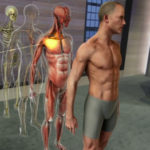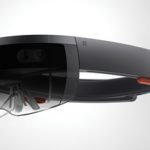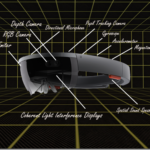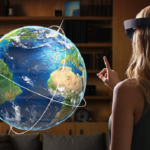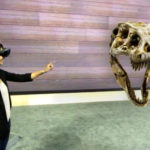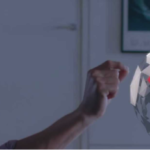Applications of 3D Holography in Online Education
Case Western Reserve University and Cleveland Clinic
3D Learning through the Eyes of a HoloLens
One of the most interesting technologies transforming the learning experience is Holography. Case Western Reserve University and Cleveland Clinic partnered to use Microsoft HoloLens and Windows Holographic to advanced medical education beyond what has previously been possible.
With the HoloLens, educators can design learning in a mixed reality 3D world. Take a look as Professor Mark Griswold from Case Western Reserve University demonstrates the new way they teach anatomy and physiology in an online and blended learning environment.
“My job is to teach and I really think this could impact almost everything that we teach people. With HoloLens you can see the muscles on top of the skeleton all at the same time you can bring them in and out and exactly understand where things sit.
“You can take any anatomical heart and show any of it. You can move it around you can make it kind of translucent so you can see through the outside and that really helped me understand like how cardiac anatomy worked.
As you can see holography not only transforms medical education, but can change learning experiences across many disciplines. Imagine what the next generation of teaching and learning will look like as we embrace holography. The most exciting part is that we get to help to define that future together.
Holography is a mind-blowing technology that is definitely making the grade at Case Western Reserve University, engaging students in multi-dimensional learning that is active, authentic and customized. A hologram is a three-dimensional, free-standing image created with photographic projection and viewed with the help of special headsets and other wearable equipment.
What Is A Hologram?
Pioneering devices like Microsoft’s new HoloLens headset are rapidly being developed to extend this powerful learning technology in novel and previously unimaginable directions.
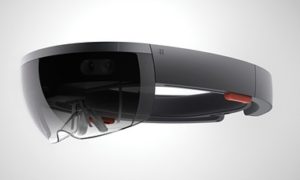 In joining forces to reinvent the future of medical education, Case Western Reserve University and the Cleveland Clinic partnered with Microsoft to use its HoloLens technology for transforming the way medical, dental and nursing students learn about the human body, something that has, until now, always required physical labs and human cadavers. But with holography, students can cut into a virtual, three-dimensional human body to understand the intricacies of and connections among all of its systems – organ and skeletal, vascular and nervous. From all accounts this approach is beginning to pay big dividends for Case Western students.
In joining forces to reinvent the future of medical education, Case Western Reserve University and the Cleveland Clinic partnered with Microsoft to use its HoloLens technology for transforming the way medical, dental and nursing students learn about the human body, something that has, until now, always required physical labs and human cadavers. But with holography, students can cut into a virtual, three-dimensional human body to understand the intricacies of and connections among all of its systems – organ and skeletal, vascular and nervous. From all accounts this approach is beginning to pay big dividends for Case Western students.
Mark Griswold, a forward-thinking professor of radiology there, is harnessing the power of holography to provide his students with a unique opportunity to examine a holographic human heart as it functions in three-dimensions. And the experience has made it much easier for them to understand how this vital system works from the inside out.
Hologram Technology in the Learning Environment
The wearable technology enables students and faculty to experience a 3D virtual world of content. For Griswold’s students, examining a holographic heart completely changes the learning experience. One of his students, Satyam Ghodasara usually cuts into a cadaver to understand the intricacies of the body.
Satyam was quoted in Microsoft’s CWRU case study. “There’s the aortic valve,” he exclaimed as he used Microsoft’s device to examine a holographic heart. “Now I understand…I see it truly in 3D. You can take parts in and out. You can turn it around. You can see the blood pumping – then entire system.”
Cleveland Clinic is building a 485,000 square-foot health education campus and is in the process of building a full digital anatomy curriculum. Case Western Reserve University and Cleveland Clinic are the first to release a third-party app for the Microsoft HoloLens. Focusing on anatomy, the first portion of the HoloAnatomy curriculum is available now. They continue to develop a full curriculum to be released by the time their new facility is completed in 2019.
Holography and Mixed Reality Across Education
Case Western is beginning to deploy this technology in other areas of study such as with the engineering students in Professor Marc Buchner’s classes who use HoloLens to model molecules and develop gaming applications.
The HoloLens allows students to engage hands-on many subject areas by reaching new dimensions of understanding. By creating a more visual and tactile experience, the HoloLens mixes reality with virtual worlds.
Holography made it possible for an art history student to “restore” a sculpture at the Cleveland Museum of Art. Other education applications in development with Microsoft and educational institutions or scientists putting holographs in schools include:
- NASA’s Jet Propulsion Laboratory developed software that allows earth-based scientists to work on Mars with a specially designed rover vehicle.
- Students here to take part in archeological digs around the world.
- Astronomy students stand in the midst of colliding galaxies, securing a front-row view of the unfolding chaos.
- Art history professors present masterpieces in their original settings—a centuries-old castle, or even the Sistine Chapel
A brilliant future is expected as many educational institutions continue to explore the unlimited possibilities of applying holography and mixed reality in education.

